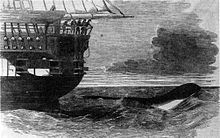 The Daedalus sea serpent of 1848 The Daedalus sea serpent of 1848
| |
| History | |
|---|---|
| Name | HMS Daedalus |
| Ordered | 23 July 1817 |
| Builder | Sheerness Dockyard |
| Laid down | November 1822 |
| Launched | 22 May 1826 (floated out) |
| Fate | Sold 14 September 1911 |
| General characteristics | |
| Class and type | Modified Leda-class frigate |
| Tons burthen | 1082 bm |
| Length |
|
| Beam | 40 ft 3.5 in (12.281 m) |
| Depth of hold | 12 ft 9 in (3.89 m) |
| Sail plan | Full-rigged ship |
| Complement | 300 |
| Armament |
|
HMS Daedalus was a 19th-century warship of the Royal Navy. She is primarily remembered for a reported sea serpent sighting by her captain and crew in August 1848.
History
The ship was launched as a fifth-rate frigate of 46 guns of the Modified Leda class in 1826, but never commissioned in that role, being roofed over fore and aft and then laid up in Ordinary (reserve). After spending 18 years laid up in reserve, she was raséed (cut down) at Woolwich Dockyard into a corvette, reduced to 19 guns in 1844.
In 1853, Daedalus was laid up at Plymouth Dockyard. Between March and June 1851 she was fitted out as a training ship, and transferred to the Royal Naval Reserve as a drill ship at Bristol. She was finally paid off from this role in September 1910, and sold in 1911 at Bristol to take to pieces.
Sea serpent sighting

On 6 August 1848, Captain McQuhae of Daedalus and several of his officers and crew (en route to St Helena) saw a sea serpent which was subsequently reported (and debated) in The Times. The vessel sighted what they named as an enormous serpent between the Cape of Good Hope and St Helena (reported by the captain as 24°44′S 9°22′E / 24.733°S 9.367°E / -24.733; 9.367; off the coast of modern-day Namibia). The serpent was witnessed to have been swimming with four feet (1.2 m) of its head above the water, with 60 feet (18 m) "of body in a straight line on the surface", and observers estimated there was another 30 to 40 feet (9.1 to 12.2 m) of the creature underwater.
Captain McQuahae also reported that the creature was dark brown and had a yellowish white colour around its throat and was moving at 12 to 15 miles per hour (10 to 13 kn; 19 to 24 km/h). Captain McQuahae also said that "The creature passed rapidly, but so close under our lee quarter, that had it been a man of my acquaintance I should have easily have recognised his features with the naked eye." According to seven members of the crew, it remained in view for around 20 minutes. Another officer wrote that the creature was more of a lizard than a serpent.
In 2015, evolutionary biologist Gary J. Galbreath contended that what the crew of Daedalus saw was a sei whale.
Sources
- "Big eels and little eels" in Eagle Annual 1968, Oldhams Books Limited, Holland, 1967, p 118.
- "Don't Shoot the Albatros!: Nautical Myths and Superstitions" by Jonathan Eyers, A&C Black, London, UK, 2011, p 87.
- The Sail and Steam Navy List: All the Ships of the Royal Navy 1815–1889 Rif Winfield and David Lyon. Chatham Publishing, 2004. ISBN 1-86176-032-9.
References
- "HMS Daedalus (1826)". The Victorian Royal Navy.
- ^ "The Great Sea-Serpent". Gleason's Pictorial Drawing-Room Companion. Vol. III, no. 1. Boston. 3 July 1853. pp. 4–5. Retrieved 5 January 2025 – via Internet Archive.
- "Mystery of the Daedalus Sea Serpent SOLVED in Skeptical Inquirer" (Press release). Center for Inquiry. 28 August 2015. Retrieved 5 January 2025 – via centerforinquiry.org.
- Galbreath, Gary J. (October 2015). "The 1848 'Enormous Serpent' of the Daedalus Identified". Skeptical Inquirer. Vol. 39, no. 5. Retrieved 5 January 2025 – via skepticalinquirer.org.
Further reading
- Willis, Matthew (2013). Daedalus and the Deep. Cortero Publishing. ISBN 978-1611792676. — historical fiction
- "The Great Sea-Serpent". South Australian Gazette and Mining Journal. 15 February 1849. p. 4. Retrieved 5 January 2025 – via newspapers.com.
| Leda-class frigates | |
|---|---|
| Leda class | |
| Modified Leda class | |
| List of frigate classes of the Royal Navy | |